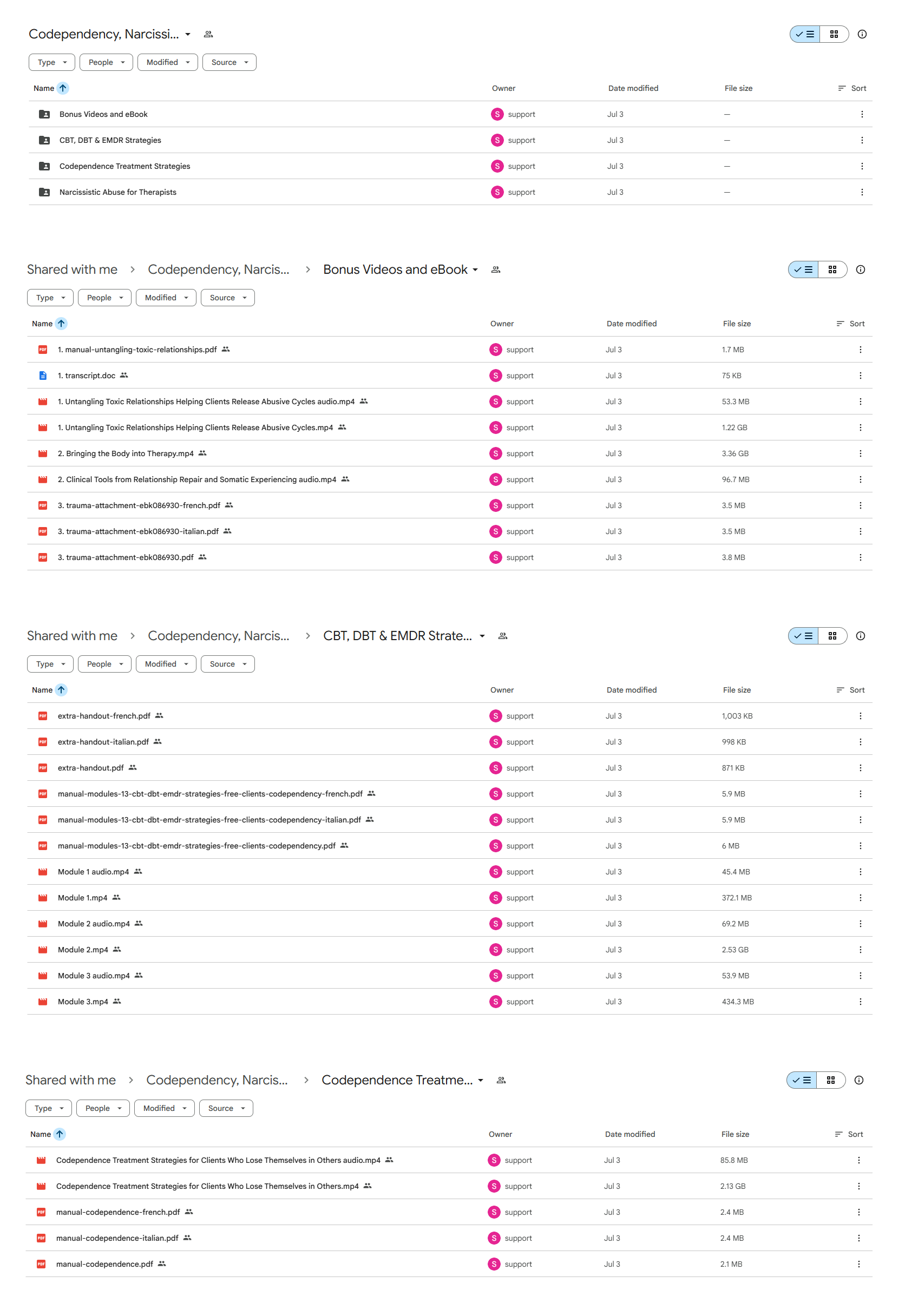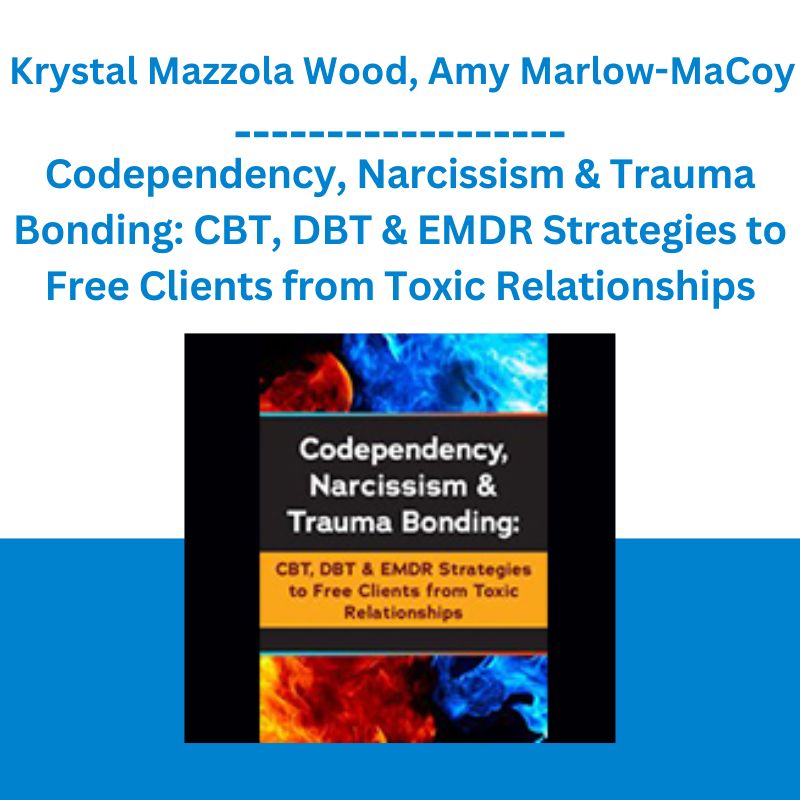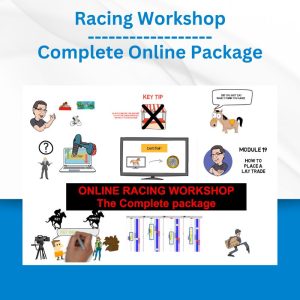*** Proof of Product ***

Exploring the Essential Features of “Codependency, Narcissism & Trauma Bonding: CBT, DBT & EMDR Strategies to Free Clients from Toxic Relationships – Krystal Mazzola Wood, Amy Marlow-MaCoy & Nancy Johnson – PESI”
Without your help, clients can rarely navigate the road to healing from gaslighting, codependency, torn attachment, narcissistic abuse, and the grief toxic relationships cause.
While you might easily recognize the signs that a client’s sense of self is shattered…
Many therapists don’t have dynamic and specific tools to help their clients overcome the debilitating damage of these relationships.
Sharpen your healing skills with easy-to-integrate interventions from the most in-demand approaches, like CBT, DBT & EMDR, to empower your clients to move their lives forward.
This comprehensive course brings together an expert panel of speakers who’ve devoted their professional careers to helping clients overcome the abuse and pain from toxic relationships. Now you can learn the skills and insight that they’ve honed through more than 100 years of combined clinical and research experience.
- Treat co-occurring anxiety, PTSD, SUDs, Personality, Mood, & more
- Restore rationale thought to clients who’ve been manipulated
- Apply insights from research on love bombing, gaslighting, & more
- Strategies for clients emerging from romantic, work, family, or other toxic relational trauma
Guide clients through the grief of past, present, & future losses
Be the therapist that helps their clients learn to be vulnerable again — get ready to transform your skills and your client’s lives.
Here’s what you’ll own in your professional library…
- Unlimited access to over 21 hours of expert training content
- A free eBook, downloadable worksheets, assessment tools, and client exercises
- Printable training manuals you can refer to again and again throughout your career
All while refining and expanding your concrete, in-session skill set!
What You’ll Discover!
Get tailored tools for treating clients who’ve experienced traumatizing relationships — whether at work, in romance, with family members, or other places. Expand your scope of practice and help your clients rebuild their lives.
CBT, DBT & EMDR Strategies to Free Clients from Codependency, Narcissistic Abuse & Attachment Trauma
Krystal Mazzola Wood, LMFT
Get essential skills from CBT, DBT, EMDR, Mindfulness & Narrative Therapy to move your clients forward in life after toxic relationships, attachment trauma, narcissistic abuse and more. In just three self-paced modules, you’ll learn everything below:
Codependency: What you need to know
- What codependency isn’t
- New research: narcissistic abuse, gaslighting, lovebombing
- How codependency develops in childhood & adulthood
- Trauma areas specific to codependency — bullying, rejection, social disconnection, IPV, infidelity, betrayal & addiction
Assessment and Diagnosis: Core symptoms of codependency
- Red flags of codependency: common client statements, ruminations & more
- Combat tendency to neglect, abuse, or self-sabotage
- Explore core & empowerment shame issues
- Comorbidities: SUDs, anxiety, PTSD, CPTSD, Personality & Mood Disorders
- Exploring your client’s loss of self
Dive into Problem Areas: Distorted Reality, Boundaries, Control & Relationships
- Overcome roadblocks: resentment, people pleasing, approval seeking
- Manage perfectionism, fantasy thinking & damage from gaslighting
- Improve guilt, trust, catastrophizing & polarized thinking
- Improve intimacy issues & heal fears of abandonment
- Assessment checklist & more worksheet
Roadmap for Treatment: The 4-Core Treatment Stages
Phase one: Guide Clients’ Self-Work
- Build client insight & awareness to destructive patterns
- Implement narrative therapy & journal writing prompts
- Nervous system balancing exercises: yoga, mindfulness, medication & more
- Combat shame with self-validation
- Teach clients how to practice patience
Phase Two: Integrate the 4-Boundary Part System
- Replace shame with self-validation
- Create internal & external boundaries in clients
- Explore 7 types of essential boundaries
- Help client’s authentic self shine
Phase Three: Trauma Healing
- Grief work specific to relationships
- Intervene in fight-flight-freeze response
- Diaphragmatic breathing — instructions & benefits
- Guide inner child and reparenting
- Healthy parenting education
- Guided scripts for self-visualization and inner child visualization
Phase Four: Relationship & Intimacy Skill Building
- Step-by-step guidance in assertiveness training
- Appropriate empathy and vulnerability
- Teach clients to accept support
- Flooding and time-outs
- Build awareness of abusive behaviors
- Interdependence — the solution to co-dependency
Dialectical Behavior Therapy Strategies and Codependency Recovery
Phase One
- Learn self-soothing toolkit & teach mindfulness to clients
- Practice radical acceptance of self & self-validation
- Discover states of Mind
- Learn ACCEPTS
- Work with the 5 senses
Phase Two
- Dialectical thinking about self, others, reality
- Radical acceptance of others
- Check facts to correct distortions
- Practice “coping ahead”
Phase Three
- Dialectical thinking
- Radical acceptance of change
- Meaning making — IMPROVE
Phase Four
- DEAR MAN, THINK & other interventions
- Broken record for boundary development
EMDR, CBT & Narrative Therapy Strategies
EMDR
- Container
- Butterfly hug
- Safe place
- Negative cognitions and validity of cognition
Cognitive Behavioral Therapy
- Thinking mistakes
- Challenge and Replace Negative Thoughts
- Response prevention plan
- Effective problem solving
Narrative therapy
- Deconstruct the socially constructed self
- Writing as therapy
- Externalize inner critic
Self of the Therapist: How Your Work Supports Therapy
- Prevent clients from entering a co-dependent relationship with you
- Examine personal experiences and biases
- Impact of pervasive codependent messages in culture
- Manage perfectionism
- Role model self-compassion & boundaries
Two case-studies
- “Savannah” codependency with comorbidity of PTSD and BPD
- “Leticia” codependency with comorbidity of anxiety
Narcissistic Abuse for Therapists: Empower Clients to Break Free and Recover from Gaslighting, Emotional Manipulation and Coercion
Amy Marlow-MaCoy, LPC
Get clients to overcome the toxic legacy of their most challenging relationships with narcissists and other abusers.
A Clinician’s Guide to Narcissism:
Narcissistic Personality Disorder and the Spectrum of Narcissistic Traits
- DSM-5™ criteria for Narcissistic Personality Disorder
- Social and culturally acquired definitions
- The spectrum of narcissistic traits
- Narcissistic traits without meeting criteria for NPD
- Psychoeducation for survivors about NPD, narcissistic behavior and its consequences
Narcissistic Abuse and General Emotional Abuse:
Similarities, Differences and Tactics Impacting Detection and Treatment
- Goals of perpetrators of emotional abuse vs. narcissistic abuse
- Cycle of abuse in narcissistic relationships
- Gaslighting and other tactics of manipulation and coercion
- What is narcissistic supply?
- Subtypes: engulfing and ignoring/neglecting
Narcissistic Abuse in Specific Relationships:
Dynamics and Impacts
- Romantic/intimate relationships/sex addiction
- Co-parenting vs. counter-parenting
- Friendships and frenemies
- Family of origin — the golden child, black sheep, scapegoat, and invisible child
- Lack of self-esteem, difficulties trusting others, C-PTSD and other effects of narcissistic abuse
Potential Missteps and Traps to Avoid
- Everyone’s a narcissist (over-pathologizing problematic behaviors)
- No one’s a narcissist (dismissing client reports because you can’t diagnose NPD)
- Pushing for reconciliation or family therapy
- Inadvertently gaslighting clients by questioning hard-to-spot emotional manipulation
- Not focusing enough on calming the underlying trauma triggers
Victims of Narcissistic Abuse in Therapy:
Break the Cycle of Abuse through Increased Autonomy, Agency and Sense-of-Self
- Building assertiveness and individuation — strategies to help clients be their own individual
- Exercises to help clients discover their own preferences, interests, desires, and goals
- Teach clients to distinguish between assertiveness, aggression, and passive aggression
- Counteract internalized messaging that assertive communication is harmful, cold, cruel, or harsh
- Prepare clients for the backlash that often attends increasing autonomy and agency
- Cultural sensitivity considerations
- Exploring levels of contact and clients’ wishes regarding contact
- Developing healthy boundaries — how to best protect themselves within the relationship parameters they choose
- Processing guilt/shame over setting boundaries and saying no
- Coping strategies for when contact is inevitable
Additional Approaches and Considerations
- Trauma competency — an essential for working with these clients
- Inner child work to heal attachment wounds
- Is family therapy advised?
- Specific modalities to explore – AEDP, IFS, EMDR, SE, BSP, Gestalt
- Research, risks and treatment limitations
Codependence: Treatment Strategies for Clients Who Lose Themselves in Others
Nancy Johnson, LPC, LSATP, MAC, NCC
Get skills to help any client overcome codependent behaviors, thoughts, and debilitating feelings. You’ll walk away with skills to help re-orient clients to themselves, such as:
- Over-focused on caring for, fixing, controlling, pleasing, and/or conflict-avoiding
- Specific strategies for adult children of an addict
- Shift client’s focus from the external to the internal & get them talking about themselves in session
- Help clients get in touch with their suffering, instead of downplaying it
- Guidance on how to help clients in abusive relationships
- Empower clients to overcome their fears that keep them from making life changes
All in simple, non-stigmatizing language that helps clients change their lives for good!
Please see the full list of alternative group-buy courses available here: https://lunacourse.com/shop/










 Greg Loehr - Advanced Option Trading With Broken Wing Butterflies
Greg Loehr - Advanced Option Trading With Broken Wing Butterflies  Trade Like Mike - The TLM Playbook 2022
Trade Like Mike - The TLM Playbook 2022  Crypto Dan - The Crypto Investing Blueprint To Financial Freedom By 2025
Crypto Dan - The Crypto Investing Blueprint To Financial Freedom By 2025  Dave Landry - Stock Selection Course
Dave Landry - Stock Selection Course  Toshko Raychev - Profit System + ITF Assistant
Toshko Raychev - Profit System + ITF Assistant  Money Miracle - George Angell - Use Other Peoples Money To Make You Rich
Money Miracle - George Angell - Use Other Peoples Money To Make You Rich  Chris Capre - Advanced Price Action Ongoing Training & Webinars
Chris Capre - Advanced Price Action Ongoing Training & Webinars  The Daily Traders – Exclusive Trading Mentorship Group
The Daily Traders – Exclusive Trading Mentorship Group  Fred Haug - Virtual Wholesaling Simplified
Fred Haug - Virtual Wholesaling Simplified  Oliver Velez - Essential Strategy Of Trade For Life
Oliver Velez - Essential Strategy Of Trade For Life  Julie Stoian & Cathy Olson - Launch Gorgeous - Funnel Gorgeous Bundle
Julie Stoian & Cathy Olson - Launch Gorgeous - Funnel Gorgeous Bundle  Ed Ponsi - Forex Trading
Ed Ponsi - Forex Trading  SMB - Options Training
SMB - Options Training  Atlas API Training - API 570 Exam Prep Training Course
Atlas API Training - API 570 Exam Prep Training Course  Matthew Kratter - Trader University
Matthew Kratter - Trader University  Forexmentor - Recurring Forex Patterns
Forexmentor - Recurring Forex Patterns